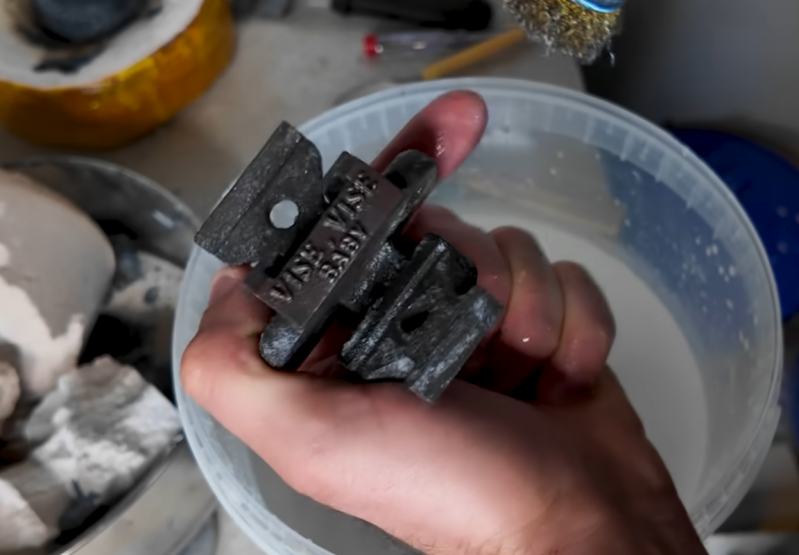Perhaps the biggest hurdle to starting a home blacksmithing operating is the forge. There’s really no way around having a forge; somehow the metal has to get hot enough to work. Although we might be imagining huge charcoal- or gas-fired monstrosities, [Shake the Future] has figured out how to use an unmodified, standard microwave oven to get iron hot enough to melt and is using it in his latest video to cast real, working tools with it. (Also available to view on Reddit)
In the past, [Shake the Future] has made a few other things with this setup like an aluminum pencil with a graphite core. This time, though, he’s stepping up the complexity a bit with a working tool. He’s decided to build a miniature bench vice, which uses a screw to move the jaws. He didn’t cast the screw, instead using a standard size screw and nut, but did cast the two other parts of the vice. He first 3D prints the parts in order to make a mold that will withstand the high temperatures of the molten metal. With the mold made he can heat up the iron in the microwave and then pour it, and then with some finish work he has a working tool on his hands.
A microwave isn’t the only kitchen appliance [Shake the Future] has repurposed for his small metalworking shop. He also uses a standard air fryer in order to dry parts quickly. He works almost entirely from the balcony of his apartment so he needs to keep his neighbors in mind while working, and occasionally goes to a nearby parking garage when he has to do something noisy. It’s impressive to see what can be built in such a small space, though. For some of his other work be sure to check out how he makes the crucibles meant for his microwave.
















He also does some clever stuff with vacuum assist casting, repurposing a table and a shopvac, which really helps the casting detail. I’ve been imitating his work and happily melting copper and cast iron in a microwave I got for free because it was broken. He’s put years of work into refining his workflow and really has an impressive toolchain now. It can’t handle the volume that my propane fired foundry can melt, but for small batches, it is surprisingly fast compared to a massive cast refractory furnace. Like 8 minutes to have copper ready to pour.
Wow, I wish I had discovered this before I liberated the transformers from the free microwaves I’ve come across.
When you wrote “liberated the transformers from the…” I could not help hearing the theme sone of that famous animation show: “Transformers… more than meets the eye”. Then I read further and noticed it were not the kind of transformers you were referring to.
Never confuse your magnetron with Megatron.
I had no idea this was possible. This guy is off the charts creative and I like his demeanor. Now I have to see what it takes to melt metal in a microwave. I see a lot of home made equipment. It’s clear he didn’t stumble on this technique overnight. What a gem. I wonder what other metals you can melt?
You said it – he’s one of those rare people who just picks something up and pushes a scene forward in a way no-one had thought to do or perhaps thought possible.
Forge = heating and beating
Foundry = casting
Yea i was going to say “if you are melting metal in your forge, you are doing it wrong”
Words… almost like they have meaning
Thanks, I was coming here to point this out.
Blacksmithing works with iron & steel in the plastic state, not liquid.
That doesn’t undermine how cool this is, boy it’s a different thing
He’s not the first to do this – in fact, HaD has written about someone else!
https://hackaday.com/2018/06/27/a-different-use-for-microwave-oven-melting-aluminum/
Vise, not vice. A vice is a bad habit. A vise is a thing for workholding.
(don’t get me started on brake/break.)
I was thinking the same thing to.
Irony?
Its like coppery and goldy butt its maid from iron
This have me a good laugh, but the addition of “maid” was the cherry on top. 🤣🤣🤣
Eye sea watt ewe did their
Not in the UK
Depends on locality.
(don’t get me started on ignorance/arrogance.)
They are often closely allied!
‘Vice’ has always been the common spelling in the UK, though you will sometimes see ‘vise’ for imported models.
“Vise not Vice” Only in USA. Not true for people who speak (unbstardised/proper) English Lol!
This is also something that can be done on 100% renewables and off grid. It is about 1000W which can be done with few panels you just need to sync with max production and minimum consumption moment.
That man, my friends, is your current frontrunner in the first annual Ron Swanson Real Man’s Man award.